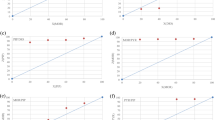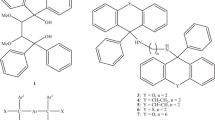Abstract
This paper is concerned with studies of weak intermolecular interactions in molecular inclusion type systems involving uncharged host and guest entities. Three new complexes of synthetic organic ligands with water and methylene chloride have been characterized by single-crystal X-ray diffraction. The hosts are composed of three cyclic urea units whose carbonyl groups are held in convergent positions by bonding their attached nitrogens to one another through two (noncyclic ligand) or three (macrocyclic ligand) rigid spacer units. Conformational organization is further enforced by an aliphatic bridge between two of the phenylene spacers in the macrocyclic hosts and an additional dimerization of the open-chain ligand. The host species were found to be particularly suitable to interact with proton donating H2O and CH2Cl2 guest moieties, as their molecular surface contains appropriately sized polar cavities lined with the carbonyl functions. Association between the interacting components in these complexes is stabilized by O−H⋯O and C−H⋯O hydrogen bonds. In the corresponding crystal structures additional molecules of the solvent are located between units of the complex. The significance of preorganization of the host structure to an efficient guest binding is emphasized by an observation that no stable complexes of a similar but unbridged macrocyclic ligand could be crystallized from the same solvent. The structural features of the inclusion compounds are described in detail, and the host-guest interaction scheme is compared to that observed in complexes of 18-crown-6 with neutral guests.
Similar content being viewed by others
References
D. J. Cram and K. N. Trueblood:Top. Curr. Chem. 98, 43 (1981); D. J. Cram, H. E. Katz, and I. B. Dicker:J. Am. Chem. Soc. 106, 4987 (1984).
J. M. Lehn:Pure Appl. Chem. 51, 979 (1979);52, 2303, 2441 (1980);
F. Arnaud-Neu, M. C. Almasio, B. Spiess, M. J. Schwing-Weill, S. A. Sullivan, and J. M. Lehn:Helv. Chim Acta 68, 831 (1985).
J. F. Stoddart: inProgress in Macrocyclic Chemistry, Vol. 2 (Eds. R. M. Izatt and J. J. Christensen), p. 179, Academic Press (1982).
A general overview of the crown-type compounds used is given by E. Weber and F. Vögtle:Top. Curr. Chem. 98, 1 (1981).
F. Vögtle, H. Sieger, and W. M. Müller:Top. Curr. Chem. 98, 107 (1981);
F. Vögtle, W. M. Müller, and w. H. Watson:Top. Curr. Chem. 125, 131 (1984).
I. Goldberg: inInclusion Compounds, Vol 2 (Eds. J. L. Atwood, J. E. D. Davies and D. D. MacNicol), p. 261, Academic Press (1984).
I. Goldberg:J. Incl. Phenom. 4, 191 (1986).
D. J. Cram, K. D. Stewart, I. Goldberg, and K. N. Trueblood:J. Am. Chem. Soc. 107, 2574 (1985).
D. J. Cram and K. M. Doxsee: To be published.
R. J. M. Nolte and D. J. Cram:J. Am. Chem. Soc. 106, 1416 (1984).
D. J. Cram, I. B. Dicker, M. Lauer, C. B. Knobler, and K. N. Trueblood:J. Am. Chem. Soc. 106, 7150 (1984).
P. Main, S. J. Fiske, S. E. Hull, L. Lessinger, G. Germain, J. P. Declercq, and M. M. Woolfson: MULTAN80.A System of Computer Programs for the Automatic Solution of Crystal Structures from X-ray Diffraction Data. Univs. of York, England and Louvain, Belgium (1980).
G. M. Sheldrick: SHELX76.Program for Crystal Structure Determination. Univ. of Cambridge, England (1976);
W. R. Busing, K. O. Martin, and H. A. Levy: ORFLS. Report ORNL-TM-305, Oak Ridge National Laboratory, Tennessee, 1962—an extensively modified version of.
D. A. Grossie, W. H. Watson, F. Vögtle and W. M. Müller:Acta Crystallogr. B38, 3157 (1982);
M. R. Caira, W. H. Watson, F. Vögtle, and W. M. Müller:Acta Crystallogr. C40, 491 (1984).
R. Kaufmann, A. Knöchel, J. Kopf, J. Oehler, and G. Rudolph:Chem. Ber. 110, 2249 (1977).
J. A. A. de Boer, D. N. Reinhoudt, S. Harkema, G. J. van Hummel, and F. de Jong:J. Am. Chem. Soc. 104, 4073 (1982).
J. A. Bandy, M. R. Truter, and F. Vögtle:Acta Crystallogr. B37, 1568 (1981).
I. Goldberg:Acta Crystallogr. B31, 754 (1975).
I. Goldberg, J. Bernstein, and E. M. Kosower:Acta Crystallogr. B38, 1990 (1982).
R. Taylor and O. Kennard:J. Am. Chem. Soc. 104, 5063 (1982).
Author information
Authors and Affiliations
Additional information
Supplementary Data relating to this article are deposited with the British Library as Supplementary Publication No. SUP 82039 (98 pages)
Rights and permissions
About this article
Cite this article
Goldberg, I., Doxsee, K.M. Binding neutral guests to concave surfaces of molecular hosts. Directional association of water and methylene chloride with hosts containing only cyclic urea binding sites. Journal of Inclusion Phenomena 4, 303–322 (1986). https://doi.org/10.1007/BF00658005
Received:
Issue Date:
DOI: https://doi.org/10.1007/BF00658005




